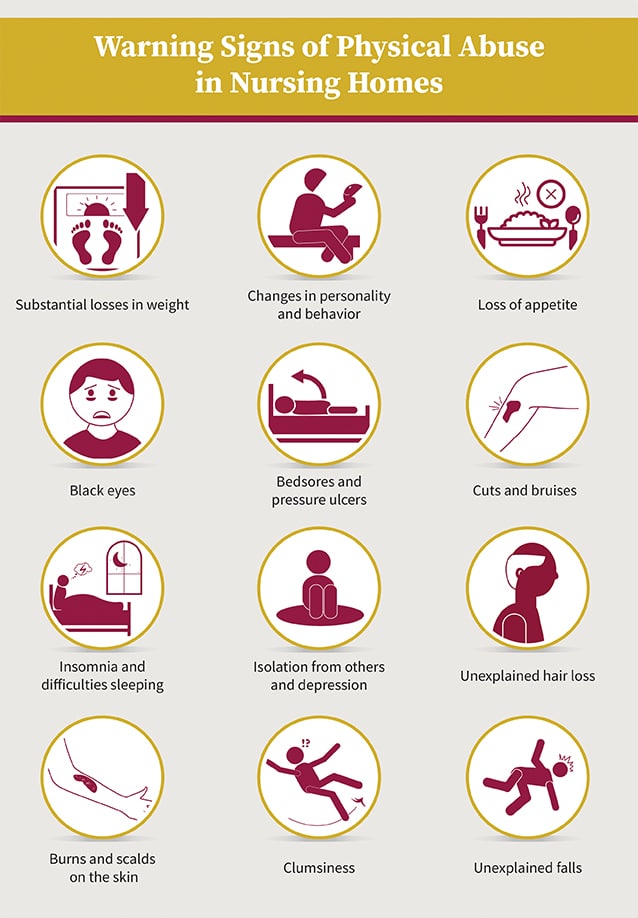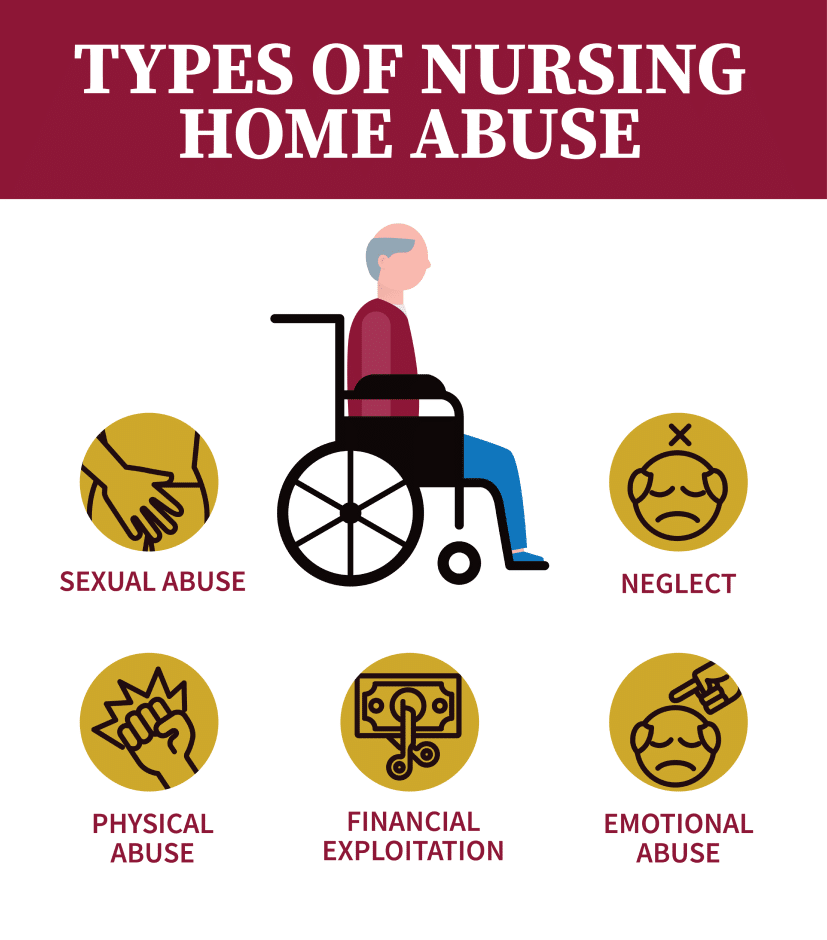Abuse in nursing homes refers to nursing home staff causing intentional or unintentional harm to their patients.
Nursing home abuse can be verbal, physical, or psychological. Similarly, the effects of
nursing home abuse can include trauma responses, depression, and even extremes such as death.
For anyone with a loved one who is knowingly or unknowingly suffering from malnourishment, dehydration, or other forms of abuse in a nursing home, it’s important to familiarize yourself with the different forms of abuse. With that knowledge, you will be in a better position to identify abuse and help your elderly family member.
1. Physical Abuse in Nursing Homes
Physical abuse refers to any mistreatment by a long-term care employee that leads to physical pain, injury, or impairment.
However, physical abuse doesn’t necessarily have to lead to severe or noticeable physical pain. The signs of certain types of physical abuse, such as malnutrition and dehydration, can be subtle and often go unnoticed.
Common types of physical abuse to be aware of include:
- Punching
- Burning the skin
- Ignoring medical conditions
- Kicking
- Tripping
- Shoving
- Threatening
- Ignoring calls for help

Warning Signs of Physical Abuse in Nursing Homes
It’s crucial to note that some nursing home residents may lack the physical and mental capacity to identify or report physical abuse when it happens. Some of these warning signs include:
Some of these warning signs include:
- Substantial losses in weight
- Changes in personality and behavior
- Loss of appetite
- Black eyes
- Bedsores and pressure ulcers
- Cuts and bruises
- Insomnia and difficulties sleeping
- Isolation from others and depression
- Unexplained hair loss
- Burns and scalds on the skin
- Clumsiness
- Unexplained falls
2. Nursing Home Neglect
Neglect occurs whenever nursing home staff fail to fulfill any part of their obligation or duties to an elder.
Neglect is apathy or indifference to a nursing home patient’s needs. It slightly differs from abuse, which is physical.
Consider the following types of nursing home neglect:
Medical Neglect
Medical neglect refers to the failure of nursing home staff to provide the patient with the medical treatment, care, or devices they need.
General Neglect
General neglect is the refusal to provide a nursing care patient with basic necessities such as food, water, shelter, medication, and personal safety measures.
General neglect in a nursing home may involve the failure to:
- Administer medication
- Provide proper sanitation
- Report infections or illnesses to nurses and doctors
- Move residents with mobility issues
- Keep the facility at favorable temperatures
- Change a senior’s clothing regularly
- Properly bathe a senior
- Change the clothes of a senior who soils themselves
- Protect vulnerable residents from accidental isolation
- Acknowledge and act on complaints by residents about staff
Warning Signs of Nursing Home Neglect
Nursing home neglect is often subtle, making it difficult for some people to recognize, exposing seniors to potential abuse.
Some of the warning signs that might identify neglect in nursing homes include:
- Poor hygiene
- Dirty bedding and clothing
- Dehydration and malnutrition
- Bedsores
- Undiagnosed and untreated illnesses
- Secondary infections and diseases
- Missed medication and doses
3. Emotional Abuse in Nursing Homes
Emotional abuse, also known as psychological abuse, occurs when a resident suffers emotional pain or stress from deliberate acts of malicious and non-physical exploitation.
It’s essential to note that emotional abuse doesn’t leave visible scars. This makes forms of emotional abuse, like verbal abuse, challenging to recognize.
Subsequently, it makes emotional abuse one of the most common forms of mistreatment in nursing homes.
Some of the different types of emotional abuse include:
- Isolation from other residents or family
- Taking away walkers, canes, hearing aids, and glasses
- Name-calling, yelling, and intimidation
- Taunting of patients
- Limiting resident freedoms such as their access to telephones and transportation
- Giving a resident the “silent treatment”
Warning Signs of Emotional Abuse
Like neglect, emotional abuse is difficult to recognize. It often takes a keen and concerned third party to identify the signs of emotional abuse in a senior.
Possible warning signs include:
- Residents displaying signs of depression
- Residents who are anxious
- Residents losing interest in their favorite activities
- Fearfulness upon visitor departure
- Symptoms of PTSD
- Extreme dislike of a particular caregiver
- Residents who are upset or agitated
- Withdrawal in previously outgoing seniors
4. Sexual Abuse in Nursing Homes
Sexual abuse refers to the intentional act of violating a resident in a sexual manner without their consent. It is also defined as non-consensual sexual contact of any kind with a nursing home resident.
Sexual abuse can occur at the hands of staff, other residents, or visitors. It includes a range of abuses. Some might be harder to detect like harassment, while others are easy to recognize such as groping or penetration.
The effects of sexual abuse are far-reaching, affecting victims physically, emotionally, and psychologically. Sexual abuse can also lead to infections, such as sexually transmitted infections (STIs), that can be especially dangerous for elderly populations.
The different types of sexual abuse in nursing homes include:

Non-consensual
touching

Coerced nudity

Sexually Explicity
Photographing

Unwanted
touching

Rape and sodomy
Warning Signs of Sexual Abuse in Nursing Homes
In most instances, sexual assault in nursing homes happens to vulnerable patients who are unable to stop advances or give consent.
Some of the observable warning signs of sexual abuse in nursing homes include:
- Unexplained pelvic pain or bleeding
- Difficulty sitting and walking
- Recurring urinary tract infections (UTIs)
- Bruising and skin irritation around the groin
- Symptoms of Post-Traumatic Stress Disorder (PTSD)
- Bloody, stained, or ripped underclothing
- Emotional withdrawal
5. Nursing Home Financial Abuse
Financial abuse in nursing homes refers to the intentional exploitation and manipulation of a patient for financial gain.
It also refers to using a resident’s funds, property, or assets in a way that is not in the best interest of the long-term care patient.
Additionally, financial abuse sometimes occurs when individuals scheme to take advantage of a patient’s inability to comprehend complex financial transactions.
This type of abuse may take several people, working inside and outside, and a lot of time before the fraud is successful.
Some of the types of financial abuse in nursing homes include:
- Forging a resident’s signature
- Stealing or misusing a resident’s money or possessions
- Manipulating a resident into signing any document
- Misuse of conservatorship, guardianship, or power of attorney
- Identity theft
- Scaring or threatening a senior into transferring assets
- Using an elder’s cash or credit cards
- Undue influence with the goal of changing a person’s last will and testament
Warning Signs of Financial Abuse in Nursing Homes
Of all nursing home abuses, financial abuse is the hardest to detect due to its complex nature. Fortunately, financial abuse involves a lengthy process, making it easier for a keen observer to identify.
Some of the warning signs of financial abuse in nursing homes include:
- Higher than usual credit card balances
- Significant changes in spending habits
- Unexplained bank withdrawals
- Receipt of letters from collection agencies
- Missing belongings or property
- Changes to an elder’s will or power of attorney
- Forgeries on legal documents and checks
6. Abandonment
Abandonment occurs when a person who has assumed responsibility for a resident’s care and well-being deserts the resident.
Some of the types of abandonment include:

Failure to check on patients regularly

Ignoring calls from the patient

Failure to aid patients in necessary tasks such as eating and moving

Not supplying proper nutrition

Not administering medication to their patients

Delays in attending to a patient
Warning Signs of Abandonment in Nursing Homes
Some of the signs that can help a concerned third party identify and report nursing home abandonment include:
- Lonely and depressed residents
- Isolation of the resident
- Bedsores
- Unexpected weight loss
- The resident withdrawing from activities they previously enjoyed



